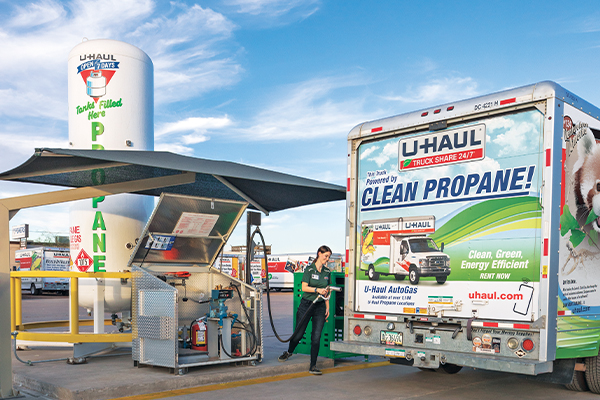Propane retailers adjust to change in 2020
The state of the U.S. propane industry in 2020 can be measured in part by the strength of COVID-19’s grip on the nation and the world.

Deemed essential during the pandemic, propane retailers have remained resilient throughout the year. Shown here is Jeremy Martin of Depew Energy. Photo by Roger Rosenbaum/Brand-News-Team
As the year drew to a close, the global pandemic had yet to loosen its grip, as health officials warned of a challenging winter ahead despite positive reports from the medical community about progress on a vaccine.
For the most part, positivity has permeated the propane industry since President Donald Trump declared a national emergency in March. The federal government deemed the delivery of propane and other fuels an essential service, and the industry went to work for its customers.
“COVID-19 demonstrated how versatile LPG is,” says Steve Kaminski, who in 2020 marked his first full year as president and CEO of the National Propane Gas Association (NPGA). “It was called upon here in the States to provide power generation and heat, to testing tents, pop-up shelters and the like.
“In California, we’ve had rolling blackouts where LPG has been called upon for vital service, including the hospitals as well as residences.
“As winter hits and the restaurant industry is decimated without full indoor dining, propane is there to heat their patios and sidewalks, and importantly but unseen to the general public, keeping industrial and agricultural customers running at full capacity during a crisis.”
Over the last nine months, propane retailers were forced into decisions that were unlike any they’ve faced in their lifetimes. In responding to the novel coronavirus pandemic, they’ve had to reassess and retool their operations for the sake of safety and efficiency. They’ve had to adapt.
“COVID has changed us – individually, corporately. It’s changed how we work, travel, contact people, how we try to make them think about propane,” says Tucker Perkins, president and CEO of the Propane Education & Research Council (PERC). “It’s changed the dialogue about propane, health and climate.”
COVID-19 follow-up
Based on the results of two LP Gas surveys this year, one in April at the outset of the pandemic and another in October, propane retailers are doing their best to navigate the COVID-19 environment.

Photo: fpm/E+/Getty Images
“We’re still growing customers as much or more [year over year],” a retailer from the Rocky Mountain region says. “Our growth outlook is fantastic and exciting. We will get through this.”
About 66 percent of more than 100 survey respondents say circumstances surrounding the virus have negatively affected their businesses only “somewhat” in 2020, and another 20 percent say their businesses haven’t been affected negatively at all. That outlook seems to have improved since the COVID-19-based survey in April when a quarter of respondents said their businesses were negatively affected “a lot” – nearly double the percentage in the survey six months later.
Another positive sign: More than 92 percent of retailer respondents say they did not lay off or furlough any employees this year due to COVID-19.
Still, that doesn’t mean circumstances haven’t been challenging.
“The stress of COVID-19 affects everybody’s attitude in some way or another,” says a Central Atlantic retailer. “As an employer, it has made my job more challenging.”
Another Rocky Mountain retailer says “people are just cranky … and frustrated with the lockdowns and everything going on.”
The lockdowns that many states put in place, especially early in the pandemic, and people spending more time at home – for work or school – have influenced propane gallon sales.
Similar to April’s survey results, more than 40 percent of respondents report no change in their gallon sales since the pandemic hit, and there’s a fairly consistent breakdown between those reporting higher (27 percent) and lower (31 percent) gallon sales. Some retailers specify their gallon sales trends aren’t all related to COVID-19 impacts, which, like weather conditions, are based on company location.
Retailers generally report an uptick in residential gallon sales this year as people rely on propane to increase their comfort level while spending more time at home.
“Customers working from home have been making improvements, adding pool heaters, fireplaces [and] generators, and they have kept us extremely busy,” says a New England retailer.
At the same time, the pandemic has hampered gallon sales on the commercial and industrial side, especially early when many nonessential businesses were forced to close.
One West Coast retailer says its forklift refilling business is off at least 30 percent this year. Another retailer cites a 20 to 25 percent volume reduction in sales across all business areas due to COVID-19.
“We believe our customers are conserving cash due to the pandemic/work reductions and getting the minimum volumes of propane during the economic uncertainty,” reports a Rocky Mountain retailer.
Keeping employees and customers safe and healthy remains an ongoing concern for retailers.
Extra cleaning and sanitizing continues to be the most popular remedy for retailers guarding against the spread of COVID-19, but many are also holding meetings outside or virtually and either closing offices to the public or installing barriers. Some companies are also increasing their spending on personal protective equipment.
“We use masks, hygiene, distance and – ultimately what few rarely use – our brains,” a Rocky Mountain retailer says.
Election season scenarios
If a global pandemic wasn’t impactful enough this year, the U.S. went to the polls in record numbers to decide its next president and a number of other key races that garnered the propane industry’s attention.
Industry members were forced to decide which candidate would better serve their business interests in a year when having the right representative in office never seemed more imperative.
“The possibility of a new administration is clearly a concern,” says a Midwest retailer, echoing many retailers’ sentiments about the election in the LP Gas survey. “President Trump is a great friend of small businesses. We need him another four years.”
As LP Gas went to press, NPGA was moving forward as if Democrat Joe Biden would become the next president of the United States. The national association also focused on the U.S. Senate, where a two-seat run-off election in Georgia would help decide control of that chamber and ultimately the power in Washington, D.C.
Republicans had secured 50 seats in the Senate and needed at least one more to maintain their majority. The Democrats retained control of the House.
During the PERC meeting in November, Kaminski noted that NPGA was putting PropanePAC support behind the two Republican candidates in the Jan. 5, 2021, run-off election.
While NPGA remained “cautiously optimistic” about the Senate race, Kaminski says, NPGA was monitoring Biden’s potential picks for his Cabinet – most notably the next Environmental Protection Agency (EPA) administrator.
“It’s very likely that the next EPA chair is going to be extremely progressive,” Kaminski says. “It makes it even more important Republicans hold the Senate so they can put a check on any Green New Deal.”
Protecting propane
NPGA’s close watch on election season races has much to do with government’s ability to enact climate-related legislation and regulations that could stymie propane industry processes and market growth.

U-Haul powers vehicles with propane autogas and now offers renewable propane in California. Photo courtesy of U-Haul International
To this point, as Kaminski shared during the World LPG Association’s (WLPGA) e-LPG Week in November, “we still don’t have a lot of significant federal restrictions when it comes to LPG use. It’s all bubbling up from the local level. We’re seeing cities and counties enacting gas bans.”
NPGA and the industry have been successful “coming in over the top on the state level,” making pushes to state legislatures to “ban the bans” and give consumers the freedom to choose their energy sources, Kaminski says. This has happened in Arizona, Louisiana, Oklahoma and Tennessee.
The association says it will continue to fight for energy diversity in as many states as possible, focusing on state legislative sessions in the early part of 2021.
To make inroads at the federal and state levels, leaders from NPGA and PERC plan in early 2021 to unveil the details of a unified environmental messaging campaign that can be used to communicate propane’s value proposition and help debunk misinformation. They also plan to work alongside state associations to help educate retailers about how to communicate those messages in their respective states.
“The electrification of everything has secured great momentum over the past couple of years,” says Blossman Gas President and CEO Stuart Weidie, chairman of PERC’s Environmental Task Force. “We as an industry do not to intend to roll over and let that movement continue unchecked.”
While the industry’s future may depend on what happens in the nation’s capital and in statehouses across the nation, some U.S. propane industry stakeholders are pushing renewable propane and dimethyl ether as clean-energy solutions that complement conventional LPG. They view these newer offerings as a way for the industry to gain a seat at the energy policy influencer’s table, especially in California.
“If we can demonstrate how propane and even cleaner versions of propane can contribute to the ultimate goals in California, we will have a proven message and blueprint to take proactively to other states that are paying close attention to California,” says Michael Stivala, president and CEO of Suburban Propane, which has entered the renewable propane marketplace.
But no matter the progress being made with renewables, industry leaders in the U.S. also say clean-burning conventional propane will have a place in the nation’s energy portfolio.
“We are committed to still tell the story about conventional propane and how it works,” Perkins says. “We’re not a bridge fuel. We are a fuel of today and a fuel of the future.”
What retailers in the LP Gas State of the Industry survey say are the biggest issues they face aside from the novel coronavirus pandemic:
- “Finding drivers.”
- “Price and competition.”
- “Customers paying invoices.”
- “Unlicensed people running gas line.”
- “The escalating cost of labor and most things.”
- “Trying to ban fossil fuels.”
- “Hiring qualified employees [who] want to work and will stay with the company.”
- “Increased price-cutting competitors.”
- “Making sure we get a cold winter.”
- “Anticipated tax increase if Biden is elected.”
- “Tank prices are out of control.”
- “Natural gas expansion [and] solar.”
- “Reduction of in-state visitors.”
- “An unstable presidential administration.”
- “Coming face to face with customers.”
- “Oil companies getting into the marketplace and driving down pricing.”
- “We have some longtime employees [who] are retiring or considering it; replacing them is going to be a challenge.”
- “Product costs, expense management and hiring qualified employees.”
- “Not enough manpower.”
- “The lack of quality contact by the retail outlet or call center with the consumer. The industry as a whole does not know how to sell.”
- “Wildfires.”
- “Trying to maintain good customer service and keeping everyone safe.”
- “Propane supply disruptions and wholesale price fluctuations.”
- “The increased demand due to housing construction in our area and being prepared to take on the added demand.”
- “Electrify-everything being pushed.”
- “Oil prices dropping, which limits our ability to convert customers to propane.”
- “The Green New Deal.”
- “Wild swings in commodity prices. Trying to find direction in the market to limit our risk exposure.”
- “Making sure we keep up margins and productivity.”
- “Government regulations.”
- “California is trying to get gas/propane out of the state.”
















